The Lucifer Hummingbird (Calothorax lucifer) is a jewel among avian species, enchanting observers with its vibrant plumage and mesmerizing flight.
These diminutive birds, measuring 3 to 3.5 inches, are native to the southwestern United States and northern Mexico, thriving in arid and semi-arid habitats.
Males exhibit a dazzling magenta throat, a distinctive feature in courtship displays, while both sexes share striking green upperparts.
Known for their territorial behavior, Lucifer Hummingbirds engage in aerial acrobatics to defend their feeding and nesting territories.
Their adaptation to challenging environments and agile foraging techniques contribute to their ecological significance.
With nests skillfully woven into the fabric of trees and shrubs, these hummingbirds encapsulate the wonders of nature, captivating bird enthusiasts with their unique attributes and captivating life history. Stay focused.
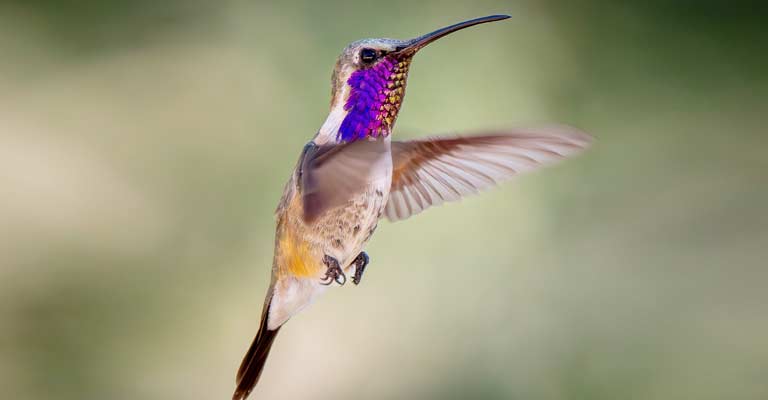
Identifying Characteristics of Lucifer Hummingbird
The Lucifer Hummingbird (Calothorax lucifer) is a captivating and distinctive bird species found primarily in the southwestern United States and Mexico.
Identifying this particular hummingbird requires attention to various characteristics, including its size, plumage, and behavior.
Size and Shape
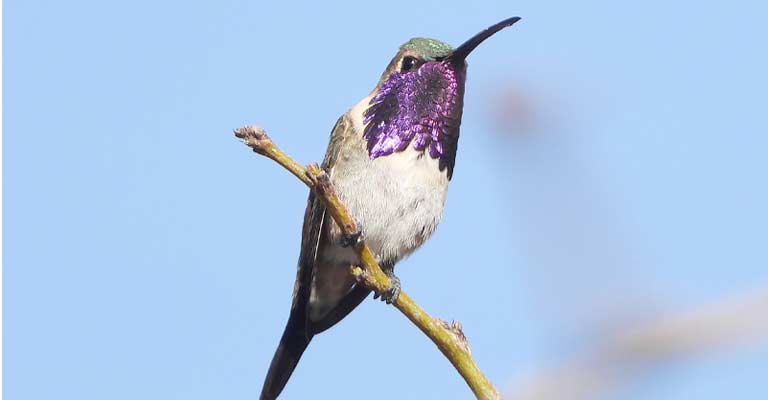
The Lucifer Hummingbird is a small-sized bird, measuring about 3 to 3.5 inches (7.5 to 9 cm) in length.
Its slender and compact build distinguishes it from larger hummingbirds. Pay attention to its petite stature and rapid wing beats, which are essential features for identification.
Plumage
One of the most striking features of the Lucifer Hummingbird is its vibrant and iridescent plumage.
Males are particularly dazzling with their iridescent purple or magenta throat (gorget), contrasting with the white or pale-colored underparts.
The upperparts of both males and females are generally green, providing a vivid contrast to the bright throat.
Tail
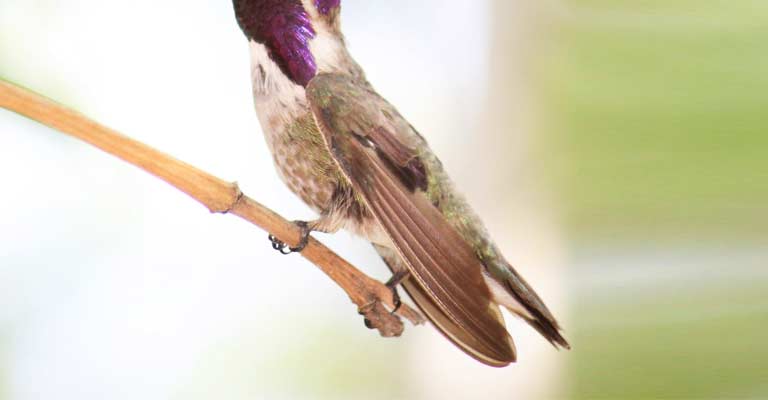
The tail of the Lucifer Hummingbird is relatively short compared to other hummingbirds.
It is typically notched or slightly forked, with the outer tail feathers often extending beyond the central tail feathers. This distinctive tail shape contributes to its unique appearance.
Bill
Lucifer Hummingbirds have relatively straight and slender bills.
The bill is adapted for feeding on nectar from flowers, and its size and shape are crucial for distinguishing this species from other hummingbirds in the region.
Behavior
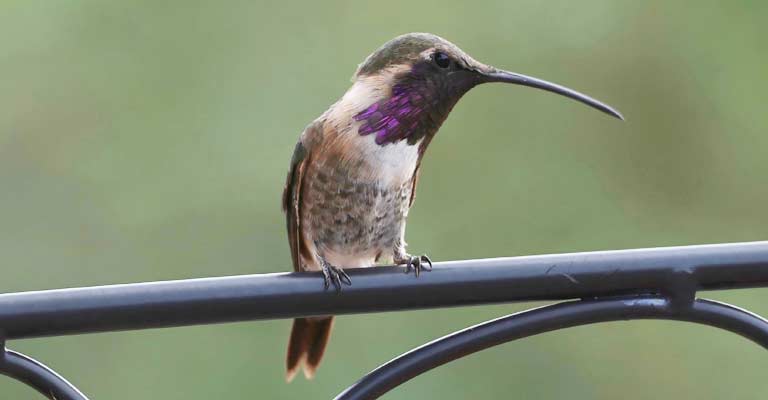
Observing the behavior of the Lucifer Hummingbird can aid in its identification. These hummingbirds are known for their agility and acrobatic flight.
They hover near flowers while feeding and may make rapid, erratic movements, showcasing their remarkable flight capabilities. They are also known to be territorial and may vigorously defend feeding or nesting areas.
Habitat
Lucifer Hummingbirds prefer arid and semi-arid habitats, including desert scrub, canyons, and mountainous regions.
Being aware of their preferred habitats can narrow down the potential locations for spotting these birds.
Range

Knowing the geographical range of the Lucifer Hummingbird is crucial for identification.
They are typically found in the southwestern United States, including Arizona, New Mexico, and Texas, as well as in parts of Mexico.
Vocalizations
While visual characteristics are paramount, familiarizing yourself with the vocalizations of the Lucifer Hummingbird can be an additional aid.
Their vocalizations include high-pitched chirps and calls, which may help you locate and identify them in the wild.
Taxonomy of Lucifer Hummingbird
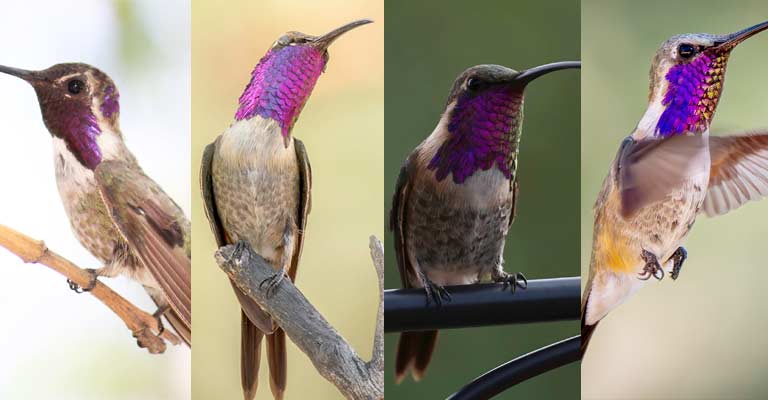
Here’s a table detailing the taxonomy of the Lucifer Hummingbird (Calothorax lucifer):
| Taxonomic Level | Classification |
| Domain | Eukaryota |
| Kingdom | Animalia |
| Phylum | Chordata |
| Class | Aves |
| Clade | Strisores |
| Order | Apodiformes |
| Family | Trochilidae |
| Genus | Calothorax |
| Species | C. lucifer |
This classification outlines the Lucifer Hummingbird’s taxonomic hierarchy, ranging from the broad domain level to the specific species designation.
Understanding the taxonomic details provides a systematic framework for categorizing and studying this fascinating bird species.
The Lucifer Hummingbird (Calothorax lucifer) belongs to the Animalia kingdom, Chordata phylum, Aves class, and is part of the Strisores clade within the Apodiformes order.
It further falls under the Trochilidae family, characterized by hummingbirds. The genus of this bird is Calothorax, and its specific species designation is Lucifer.
This comprehensive taxonomy, ranging from broader classifications like kingdom and phylum to specific genera and species, provides a systematic framework for understanding the Lucifer Hummingbird’s place in the avian world.
Lucifer Hummingbird Life History
The Lucifer Hummingbird (Calothorax lucifer) is a captivating bird species with a fascinating life history.
Understanding the various aspects of its life cycle, from feeding habits to conservation concerns, provides valuable insights into the ecology of this unique hummingbird.
Food
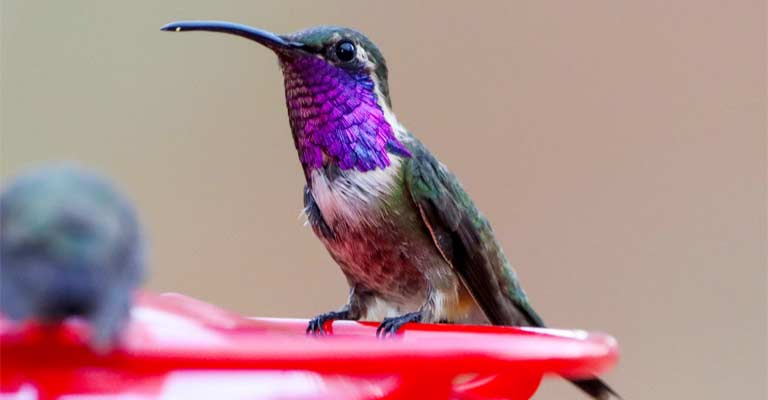
Lucifer Hummingbirds primarily feed on nectar from a variety of flowering plants.
Their specialized bills and long, extensible, tube-like tongues allow them to reach deep into flowers to extract nectar. In addition to nectar, they also catch small insects and spiders, contributing to their protein intake.
Their high metabolism demands a frequent intake of food, and they are often observed aggressively defending feeding territories.
Habitat
These hummingbirds inhabit arid and semi-arid environments, favoring areas with desert scrub, canyons, and mountainous regions.
Their adaptation to such habitats is remarkable, showcasing their resilience in the face of challenging environmental conditions.
Range Map
The Lucifer Hummingbird’s range extends from the southwestern United States, including Arizona, New Mexico, and Texas, into northern Mexico.
Consultation of a detailed range map can aid birdwatchers and researchers in tracking their distribution and migratory patterns.
Nesting
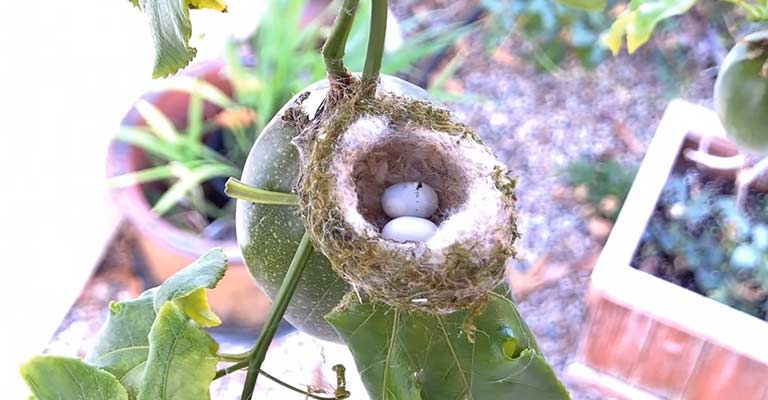
Lucifer Hummingbirds build compact cup-shaped nests typically situated in trees or shrubs. The nests are constructed using plant materials, spider silk, and feathers, intricately woven together.
Female Lucifer Hummingbirds are responsible for nest-building, and their nests are often well-camouflaged to protect against potential predators.
Here’s a table summarizing nesting details of the Lucifer Hummingbird:
| Nesting Details | Lucifer Hummingbird Facts |
| Clutch Size | Typically consists of two eggs |
| Number of Broods | Often raises one brood per breeding season |
| Egg Length | Approximately 1 centimeter (0.4 inches) |
| Egg Width | Around 0.6 centimeters (0.24 inches) |
| Incubation Period | Approximately 14 to 17 days |
| Nestling Period | Roughly 20 to 26 days |
| Egg Description | Small, white, and elliptical in shape |
| Nest Construction | Compact cup-shaped nests |
| Nest Material | Woven with plant materials, spider silk, and feathers |
| Nest Placement | Typically in trees or shrubs, often well-camouflaged |
| Parental Involvement | Both male and female participate in incubation and chick rearing |
| Courtship and Mating | Involves elaborate displays, aerial acrobatics, and flashy movements |
| Predation Risks | Nests may face threats from predators like snakes and birds |
| Threats to Nesting Sites | Human disturbance, habitat destruction, and climate change |
These details provide an overview of the nesting characteristics of Lucifer Hummingbirds, highlighting their reproductive strategies, nesting behaviors, and the challenges they face during the critical phases of incubation and nestling development.
Breeding
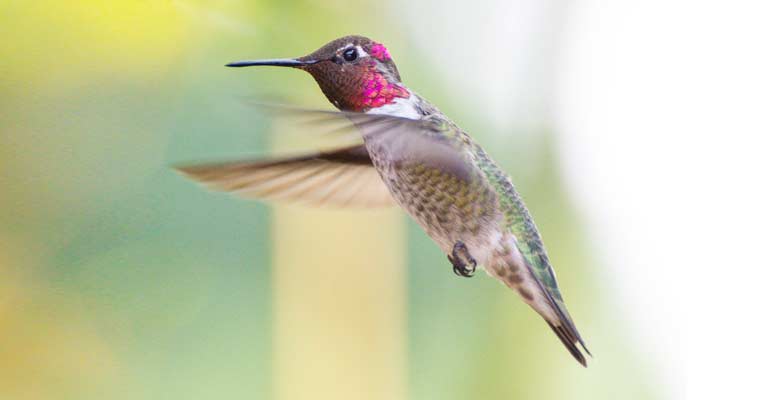
Breeding behavior is characterized by elaborate courtship displays performed by males to attract females. These displays involve aerial acrobatics, rapid flights, and flashy movements to showcase their colorful plumage.
Once a pair forms, the female lays two small white eggs, and both parents participate in incubation and caring for the chicks.
Diseases
Like all bird species, Lucifer Hummingbirds can be susceptible to diseases. Common avian diseases such as avian pox and various parasitic infections may affect their health.
Monitoring for signs of illness, such as lethargy or changes in feeding behavior, is crucial for identifying potential health issues.
Treatment
In cases of disease, early detection and appropriate treatment are essential for the well-being of Lucifer Hummingbirds.
Avian veterinarians and wildlife rehabilitation centers play a crucial role in providing care and treatment.
Efforts to mitigate the spread of diseases include maintaining clean feeding stations and minimizing stress on the birds.
Conservation
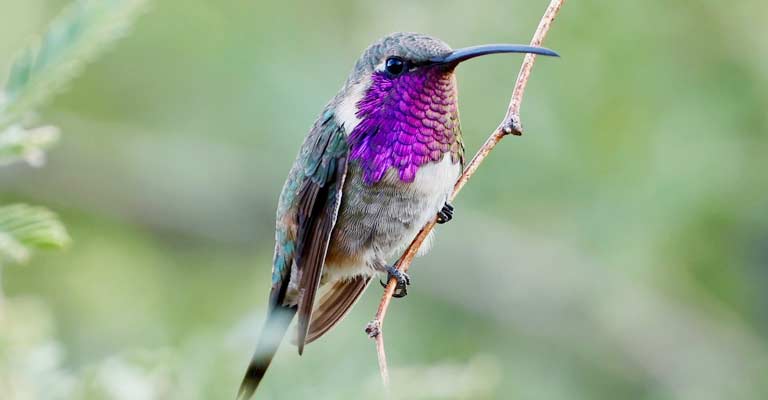
Conservation efforts are vital to ensure the survival of Lucifer Hummingbirds. Protecting their natural habitats from habitat destruction and fragmentation is crucial.
Additionally, monitoring and managing human activities that may impact their breeding and feeding areas are essential for their long-term conservation.
Education and awareness campaigns can also contribute to fostering appreciation and support for the conservation of this species.
The life history of the Lucifer Hummingbird is a rich tapestry of adaptation, reproduction, and ecological interactions.
From their foraging behaviors to nesting habits and the challenges they face in the form of diseases and habitat loss, a comprehensive understanding of their life history is essential for effective conservation and appreciation of these remarkable birds.
10 Fun Facts About Lucifer Hummingbird
Lucifer Hummingbirds are fascinating creatures with several interesting and unique characteristics. Here are some fun facts about them:
- Iridescent Plumage: Male Lucifer Hummingbirds boast vibrant, iridescent purple or magenta throat feathers, which create a dazzling display during courtship. This striking feature is often considered one of the most beautiful among hummingbirds.
- Aggressive Defenders: Despite their small size, Lucifer Hummingbirds are known for their territorial behavior. They vigorously defend their feeding and nesting territories, engaging in aerial chases and confrontations with other hummingbirds and even larger birds.
- High Metabolism: To sustain their rapid wing beats and high energy expenditure, Lucifer Hummingbirds have an exceptionally high metabolism. They feed frequently on nectar and supplement their diet with small insects to meet their nutritional needs.
- Unique Tail Shape: The tail of the Lucifer Hummingbird is distinctive, often notched or slightly forked. The outer tail feathers may extend beyond the central tail feathers, contributing to their unique appearance during flight.
- Adaptation to Arid Environments: Lucifer Hummingbirds have adapted to arid and semi-arid environments, thriving in habitats such as deserts and canyons. Their ability to extract nectar from a variety of flowering plants in these challenging conditions showcases their remarkable ecological niche.
- Migratory Patterns: While some populations of Lucifer Hummingbirds are resident year-round, others are known to undertake seasonal migrations. Understanding their migratory patterns adds layer of complexity to their fascinating life history.
- Tiny Eggs: The eggs of Lucifer Hummingbirds are exceptionally small, measuring only about 1 centimeter in length. Despite their diminutive size, these eggs play a crucial role in the continuation of the species.
- Acrobatic Flight Displays: During courtship, male Lucifer Hummingbirds engage in acrobatic flight displays to attract females. These displays involve rapid dives, climbs, and mid-air maneuvers, showcasing their agility and coordination.
- Nesting Material Selection: Lucifer Hummingbirds use a variety of materials to construct their nests, including plant materials, spider silk, and feathers. The intricate weaving of these materials results in well-camouflaged nests, protecting their eggs and chicks.
- Challenges from Predators: Nests of Lucifer Hummingbirds face threats from various predators, including snakes, birds, and other animals. Their ability to build concealed nests and their vigilant defense strategies are essential for ensuring the survival of their offspring.
These fun facts highlight the remarkable adaptations, behaviors, and characteristics that make the Lucifer Hummingbird a truly captivating species in the world of birds.
Wrapping Up
The Lucifer Hummingbird stands as a testament to nature’s marvels, blending vibrant beauty, territorial prowess, and resilient adaptations.
From its dazzling plumage to acrobatic courtship displays, the intricacies of its life history reveal a captivating species thriving in arid landscapes.
Appreciating these details not only enriches our birdwatching experiences but also underscores the importance of conservation efforts to safeguard these remarkable hummingbirds and their habitats. Thank you very much.